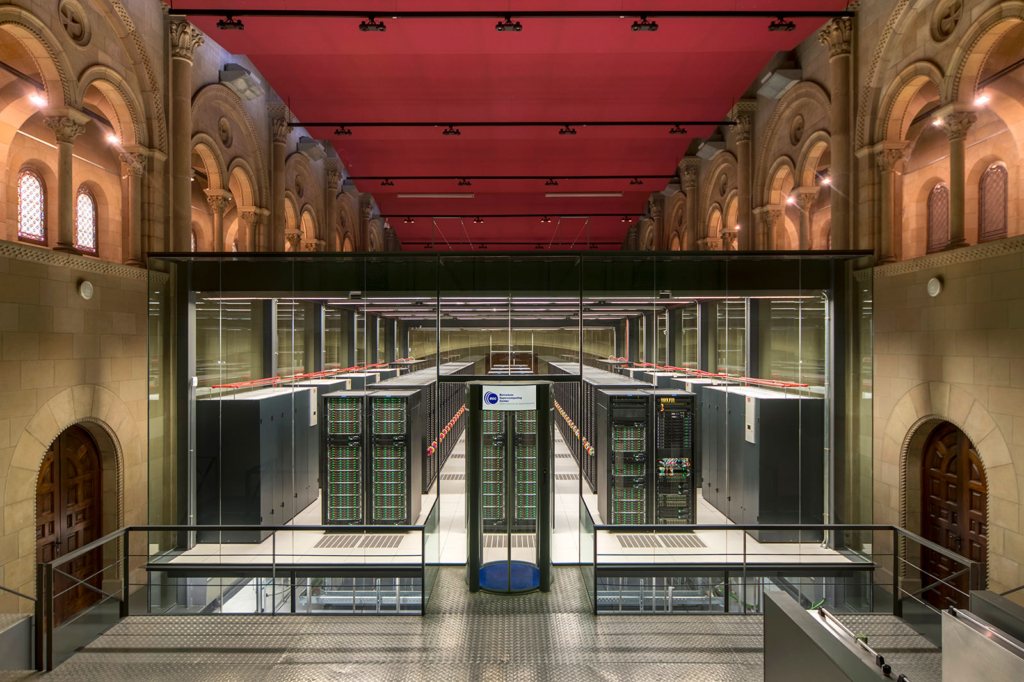This article is brought to you by Datawrapper, a data visualization tool for creating charts, maps, and tables. Learn more.
The race to build the fastest supercomputer
Hey, this is Eddie from Datawrapper’s support team. I spend more time than I’d like to admit in front of my laptop, so I decided to write about computers this week.
If you think of the most powerful machines on Earth, you probably don’t think about your desktop computer — but there are computers out there big enough to occupy a building. We generally know these as ”supercomputers,” machines capable of performing quadrillions of calculations per second. According to IBM, supercomputers can have one million times more processing power than the fastest laptop.
Last summer, I visited one: the MareNostrum, in Barcelona, the most powerful supercomputer in Spain and one of the most powerful in Europe. Its facility is housed in a former chapel, so the view is quite impressive! I’d recommend visiting it if you’re in Barcelona, but you can also do it virtually. This center is used by researchers from all around the world to investigate anything from weather forecasting to the human genome or geological modeling.

The MareNostrum is part of the TOP500, a list of the best-performing supercomputers in the world that is updated twice a year and maintained by several university researchers. In November 2021, they published their 58th edition, where the Japanese Fugaku defended its position as the fastest computer anywhere, at a speed of 442 petaflops. “Flops” are the number of basic arithmetic operations a computer can perform in one second, and the prefix “peta” means one quadrillion, or 10¹⁵.
These are the other supercomputers on the list:
However, just the number of supercomputers doesn't tell us much about how powerful each of these machines are. For example, the supercomputer Fugaku is almost three times faster than the second-place winner, the American Summit, manufactured by IBM. Fugaku is currently used for coronavirus-related research on drugs, the virus's proteins, and the establishment of COVID-19 safety guidelines for the government and private sector in Japan.
Apart from Japan, just a small handful of countries host the top 10 fastest supercomputers in the world: the list includes five American machines, and two run by the Chinese government. Only two European machines make the cut: the German JUWELS, owned by the IT company Atos, and the Italian HPC5, manufactured by DELL.
The evolution of supercomputers
Since the early '90s, the race to build the fastest computers in the world has been contested mainly between the U.S. and Japan. However, China has been producing more and more supercomputers, and now has more spots on the TOP500 list than any other country — 173, more than a third of the total. The country with the second-largest number of machines included on the list is the U.S., with 149.
But why does it matter where these supercomputers are? Well, these powerful machines can be used to tackle complex problems, so that means that governments with access could have an extra tool to help during complicated situations, such as pandemics or war.
"Supercomputing provides a technological advantage for DOD (US Department of Defense) projects. It helps to reduce costs by reducing reliance on expensive and destructive live experiments and prototype demonstrations. We empower researchers to solve the most difficult military operational challenges through advanced computing," explains Dr. Raju Namburu, director of the Army Research Laboratory (ARL) in the U.S.
According to The Next Platform, citing an anonymous source, China could already be operating two of the fastest supercomputers in the world, capable of more than one exaflops (10¹⁸ floating-point operations per second). One of these supercomputers is supposedly called the Oceanlite, a successor to Sunway TaihuLigh, which is believed to have reached 1.3 exaflops, or 1.3 quintillion operations per second. It is not known why China has not disclosed these two supercomputers for them to be included in the TOP500 ranking.
In the US, chipmakers AMD and Intel have won contracts from the US Department of Energy to build exascale supercomputers, which could be completed as early as 2023, and reach a speed of two exaflops.
This market is expected to grow from $37.8 billion in 2020 to $49.4 billion by 2025, according to market research company Technavio. The largest manufacturers are the Texan Hewlett Packard Enterprise (HPE), which has made at least 84 operating supercomputers with a combined output of 564,245 TFlop/s, followed by the Japanese Fujitsu and the Chinese Lenovo.
Supercomputers are used primarily for research, but their industry and government uses are also expanding, which means more and more countries could try to join the race to build the fastest machine. From drug discovery to battling cancer, faster computers can reduce the time that it takes to carry out an experiment from hours to just a few seconds, which can make innovation happen faster.
That's all from me this week! I hope this blog post broadened your interest in supercomputers. For the researchers out there: Did you ever visit one of these facilities or operate a supercomputer? Send me an email at edurne@datawrapper.de; I'd love to hear about your experience. Next week, it will be Rose's turn to write a Weekly Chart, so stay tuned!




Comments